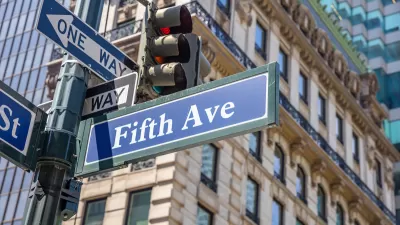Researchers who studied the appeal of New York City streetscapes find an additionally significant factor on the streets of Salt Lake City: the photo op.

A recent study by planning scholar Reid Ewing determined that three streetscape features significantly correlate to pedestrian use in NYC: active use (i.e., streets with schools, busy office buildings and parks); the presence of street furniture (such as ATMs, parking meters, and benches); and first-floor window-to-façade ratio (the proportion of windows on a building’s façade). But New York City is not called the Greatest City on Earth for nothing. As Laura Bliss writes, "There’s so much that sets New York apart from other American cities: its density, its walkability, its spread of urban versus suburban development, among others. What about smaller towns?"
Ewing’s new study of Salt Lake City suggests that to achieve walkability, planners in other cities might want to also ask: can it be Instagrammed?
The Salt Lake City study was designed to determine whether pedestrians in a less dense city with an average level of metropolitan sprawl were drawn to streetscapes with the same features found to be significant in NYC. While two of the three factors—active use and windows—contributed to the significance of what the researchers termed transparency on 179 blocks in Salt Lake City, of additional importance was the imageability of a streetscape.
Imageability, Bliss writes, "is what makes a place distinctive and memorable—a visual identity that could be made of parks or plazas, unique views or vistas, old or unusual architecture, and al fresco dining."
The relative importance of imageability is still widely unknown. However, reports last winter of young girls taking selfies in front of an active building explosion site in NYC’s East Village suggest that, as Bliss reports, "walkability is about more than density, street-level retail, or any one design quality in isolation."
FULL STORY: How Urban Designers Can Get Smaller Cities Walking

Pennsylvania Mall Conversion Bill Passes House
If passed, the bill would promote the adaptive reuse of defunct commercial buildings.

Planning for Accessibility: Proximity is More Important than Mobility
Accessibility-based planning minimizes the distance that people must travel to reach desired services and activities. Measured this way, increased density can provide more total benefits than increased speeds.

World's Largest Wildlife Overpass In the Works in Los Angeles County
Caltrans will soon close half of the 101 Freeway in order to continue construction of the Wallis Annenberg Wildlife Crossing near Agoura Hills in Los Angeles County.

Eviction Looms for Low-Income Tenants as Rent Debt Rises
Nonprofit housing operators across the country face almost $10 billion in rent debt.

Brightline West Breaks Ground
The high-speed rail line will link Las Vegas and the Los Angeles area.

Colorado Bans No-Fault Evictions
In most cases, landlords must provide a just cause for evicting tenants.
City of Costa Mesa
Licking County
Barrett Planning Group LLC
HUD's Office of Policy Development and Research
Mpact Transit + Community
HUD's Office of Policy Development and Research
Tufts University, Department of Urban and Environmental Policy & Planning
City of Universal City TX
ULI Northwest Arkansas
Urban Design for Planners 1: Software Tools
This six-course series explores essential urban design concepts using open source software and equips planners with the tools they need to participate fully in the urban design process.
Planning for Universal Design
Learn the tools for implementing Universal Design in planning regulations.


























